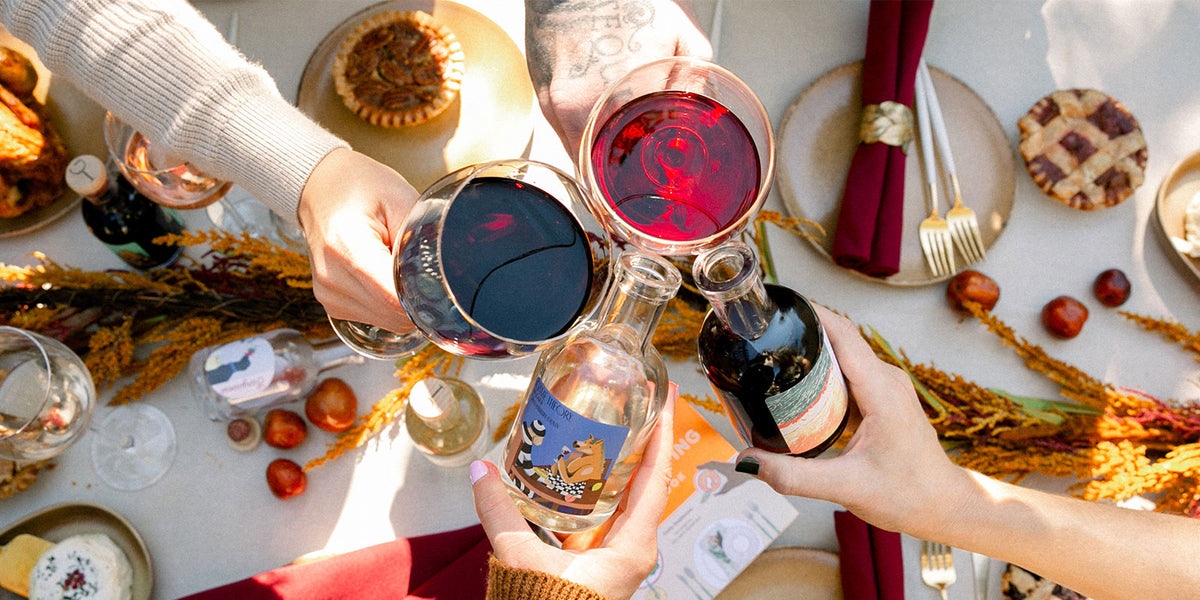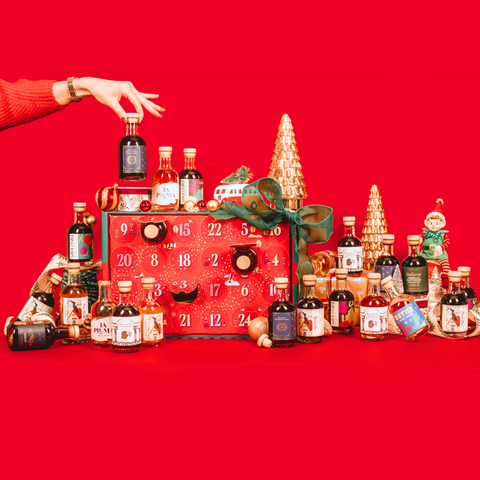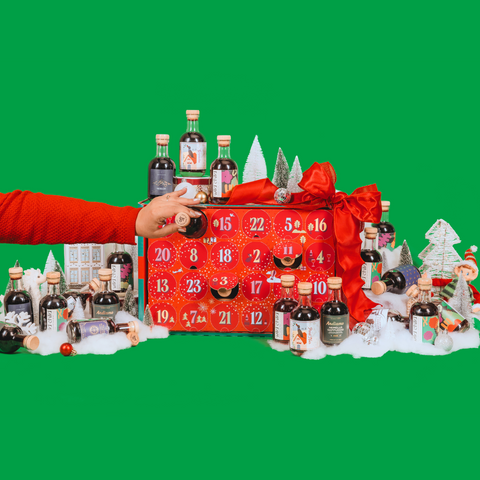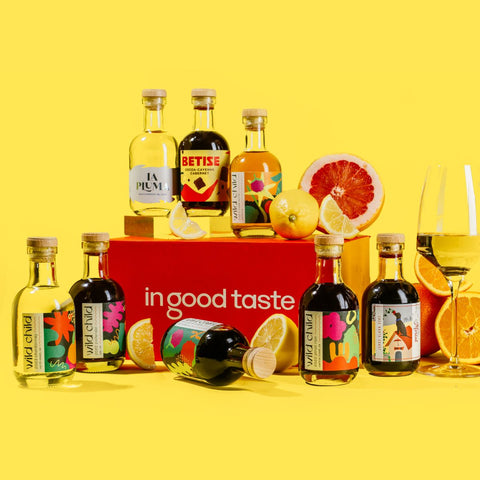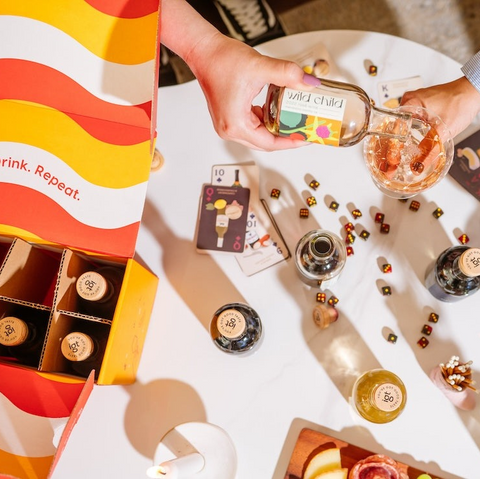Sangria by the Season
Sangria, a delicious wine punch and Spanish favorite, has a long history. In fact, its humble beginnings can be traced back more than 2,000 years ago. But even with a long, delicious history, figuring out what to put in sangria can be trickier than one would think. You see, the criteria for sangria is pretty simple: wine, chopped fruit, and whatever else you want! There are no rules on what type of wine (although most people prefer red) or fruit is used, and some sangrias are even made with different spices or spirits.
What Exactly is "Sangria"?





History of Sangria
Let’s talk about why this is the case with a look back into sangria’s origins. Early Greeks and Romans needed a solution for bacteria-ridden, unsafe water. The quick fix was to mix their table wine (that wasn’t very good) with whatever they had on hand, like sugar, spices, and anything else they could use to jazz it up. Similar to mulled wine, the creation was called “hippocras” and was drunk all the time (water was dangerous, remember). Spaniards had the same idea—likely due to their trade interactions with the Romans—but they named the drink sangria. The name stuck, and we’re glad it did! (You have to admit, a glass of sangria just sounds better than a glass of hippocras.)
History of Sangria


The criteria for sangria is just as loose today as it was when it started. It’s also evolved in the U.S. and other countries, becoming something more stylized like a cocktail (think Aperol spritz), whereas, in Spain, it’s a more simplified drink. That being said, pretty much anything goes, which can make things complicated when you’re choosing a solid sangria recipe. After all, the best sangrias are made at home!
We’ve rounded up some of our favorite sangria recipes you can make at home using different base wines to get you started. We’ve even added a few seasonal options, too.
Simple Sangria Recipes To Get You Started
Traditional Red Sangria
We know, we just said there aren’t really rules on sangria, so how can there be one that’s “traditional,” you might ask? The Minimalist Baker had the same question after seeking to make a pitcher at home that would be reminiscent of the sangria they sipped on their 2013 trip to Barcelona. We think they nailed it with this simple but lush recipe for traditional red sangria. Try it for yourself!
-
1/2 medium apple
-
1/2 medium orange
-
3-4 Tbsp organic brown sugar (or 3 Tbsp organic cane sugar in the original recipe)
-
3/4 cup orange juice (plus more to taste)
-
1/3 cup brandy (plus more to taste)
-
~1 cup ice to chill
Core and chop the apple into small pieces. Slice the orange, then quarter each slice and remove large seeds. Add brandy, and dry red wine to a pitcher a nd stir until sugar dissolves, then add fruit and ice. Pour into a glass, garnish with an orange wedge, and enjoy!
*Original recipe made with Albero Spanish Red Wine 2014 Monastrell, but any dry red Spanish wine will do
Related: Guide to Red Wine
Sparkling Sangria
Looking for a more cocktail-esque sangria? Chef Michael Chiarello has put together a tantalizing recipe that’s just as good at home as you’d get at a restaurant or bar. Made with brandy, heavy citrus, and cava, this sparkling sangria just might make you think you’ve gone to Spain for the day. Plus, it’s ready to be served right away if you’re stirring it together last minute.
-
1 cup brandy
-
1/2 cup orange liqueur
-
1/4 cup sugar, superfine
-
1 orange, thinly sliced
-
1 pint raspberries
-
1 lime, thinly sliced
-
1 lemon, thinly sliced
-
2 bottles sparkling wine or cava, chilled
Very Berry White Sangria
So how would sangria work with white wine as a base? Spectacularly! This impressive punch from Sally’s Baking Addiction is full of color, taste, and sweet white wine. Packed full of berries and citrus, this sparkling champagne sangria is sure to turn heads and taste buds with its presentation and flavor. “Crowd-pleasing” is right!
-
1 orange, thinly sliced
-
1/2 lemon, thinly sliced
-
1 cup blueberries
-
1 cup raspberries
-
10 large strawberries, sliced
-
1 cup orange juice
-
1 750ml bottle your favorite champagne
Aperol Spritz Cocktail
Ready to step up your sangria game and make a cocktail? A bubbly Italian cocktail still bends the rules in sangria, as you can change the amount of wine or club soda to your liking. Cookie and Kate’s Prosecco-based Aperol spritz recipe hits the spot with bubbles and booze without getting too complicated.
-
Ice
-
3 ounces (1 part) Aperol
-
3 ounces (1 part) dry Prosecco
-
1 ounce (a splash) club soda or unflavored sparkling water
-
Orange slice, for garnish
Drinking Sangria by the Season
The wonderful thing about sangria’s versatility is the ability to curate a pitcher for every season. You can always use seasonal fruits and spices to transition your staple sangria or simply switch up the base wine every now and then. Whether you’re hosting a book club in the spring or stirring something up for the office holiday party, you can’t go wrong with sangria.
Spring for Sangria
Sangrias made for spring are likely to be on the light and white side of the spectrum. With a white or rosé wine base, add your choice of citrus, berries, melons, sugar, and herbs. To take it a step further, add a dash of lemon-lime soda or orange liqueur for extra flavor.
Stir it up, refrigerate it for 8-10 hours, and pour over ice to put your personal twist on spring sangria.
Summertime Sangria
For summertime sangria, bring out your fresh peaches, stone fruit, mango, pineapple, blackberries, or any other summer fruit you want. Using white or red wine as a base, add your fruit selections and sprinkle in some basil. You can add some club soda for extra bubbles if you’re in the mood. With summer fruits, your final sangria will likely be hearty and packed with scrumptious, fruity flavors.
Mix all your ingredients together and refrigerate the sangria for 8-10 hours. After that, you’re ready to bring a whole pitcher to the pool!
Fall for Sangria
Fall sangrias are some of the most gorgeous glasses of sangria you’ll ever see. By mixing up a fresh sangria In the middle of pumpkin spice and apple picking season, you can prove there really is a sangria for every season. We even made a pumpkin spice sangria for Thanksgiving! If that’s too far out of your comfort zone, you can certainly stick to an apple version instead.
We recommend a red wine or cider in the cooler months, but you can still use white wine as a base if there’s your preference. Add some fresh apples, pears, cinnamon, and any other seasonal fruits and spices. For an additional kick, apple-flavored simple syrup or a splash of vodka make great choices.
Add sugar, stir, and let sit refrigerated for 8-10 hours. Then, pour yourself a glass of this marvelous fall sangria, and toast the leaves as they fall.
Related: Introduction to Grenache
Holiday Sangria
Move aside, eggnog. We’re not done with sangria just yet. Even through the holidays, sangria steps up to bring good cheer no matter what you’re celebrating. For a glass decked with holiday spirit, we recommend choosing a red wine base and cranberries galore!
Stir in some sugar and spices (we can almost taste the hints of cinnamon and nutmeg as we write about this!), and let the mixture sit refrigerated for 8-10 hours. If you’re serving it cold, just add orange slices and pour over ice. But if you want to give your sangria a holly jolly twist, you can warm up your sangria in the slow cooker for a cozy fireside drink.
How to Store Sangria
Sangria is best stored refrigerated in the pitcher you mixed it in. However, don’t let it sit too long as the fruit starts to break down and lose its freshness after approximately three days. If frozen, sangria can last up to three months! Just remove the fruit first and transfer the remaining liquid into an airtight container.
How Long will Sangria Keep?


What to Serve with Sangria
Pairing the right sangria with your meal will heavily depend on the base wine used in your sangria recipe.
Food Pairings with Sangria

White sangria: White sangria will pair best with lighter plates like charcuterie, creamy pasta, grilled chicken, lobster, and other seafood.

Red sangria: Red sangria goes well with heavier foods like steak and other red meats. It also pairs nicely with flatbreads, nuts, and heavier cheeses.

Aperol spritz/sparkling: An Aperol spritz or sparkling sangria pairs well with cured meats, smoked salmon, salty foods, and brunch plates.
And there you have it. With a little creativity, you can enjoy sangria all year long, whether it’s with just a few ingredients or a sophisticated cocktail!

